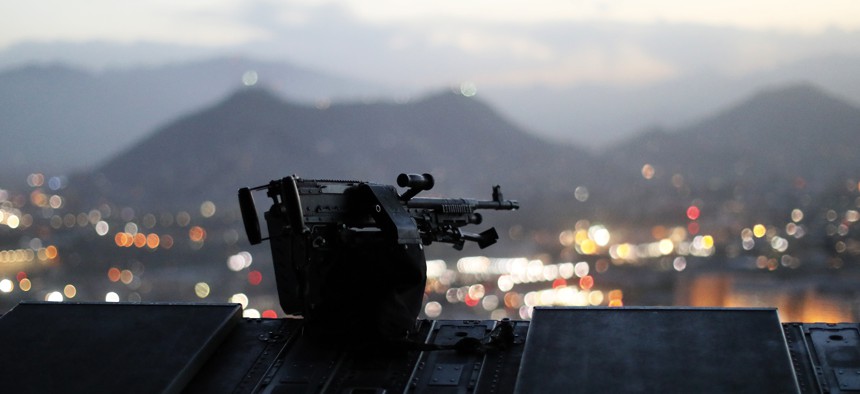
A U.S. Army helicopter departs Resolute Support headquarters with U.S. Defense Secretary James Mattis aboard in Kabul, Afghanistan, Mon., April 24, 2017. Jonathan Ernst/Pool Photo via AP
The Longest War Fades Even at NATO
Cameras focused on Trump, but war commanders in Afghanistan wanted more troops from NATO, not promises.
This was the big stage and the NATO spotlight. At least it was supposed to be. For months, U.S. commanders said they needed thousands more NATO and American troops to help Afghans hold back the resurgent and unrelenting fighting of more than 20 terrorist groups across the country. They looked to their commanders in chief, their heads of state, to commit to a mini-surge of advisors, some help with counterterrorism operations, and renewed pressure on Pakistan to do more on its side of the border.
Instead, the Afghanistan War is so forgotten – or, we are so numbed – it now fades into the background even at the headquarters of the very organization tasked to fight it: NATO.
Afghanistan was overshadowed by President Donald Trump’s first visit to a NATO summit and his message on financial burden-sharing targeted at Europe. Nearly no mention of NATO’s continuing mission in Afghanistan could be spotted in the headlines coming out of Europe. It was just talk of transatlantic tensions and bills due to Washington.
Here’s what the NATO summit coverage left out: Afghan leaders and U.S. generals mired in a very long war in which Afghan forces are taking an unsustainable level of casualties received more of the same vague assurances they’ve heard for years, that members are “in support” of the Resolute Support mission but there are still no decisions on troop levels for 2018. Defense Secretary Jim Mattis last week said he was “very soon” to make his recommendation to the White House, but it was not in time for the summit. So the up or down on whether to add “a few thousand more” troops to support the training and advising of Afghan forces., which Gen. John Nicholson, top U.S. war commander in Kabul, advocated for on the Hill this past February still awaits Mattis, and the rest of the Trump administration. That conversation is said to be riven by the same divides that marked the Obama administration: to do or not to do, and how many, for how long and to what end.
Related: NATO, Dunford Laying Groundwork to Send More Troops To Iraq, Afghanistan
Related: The Trump Effect: One Path To A New NATO
Related: ISIS-in-Afghanistan Is Losing Recruits to Other Groups, US Officials Say
"It shouldn't take too long. I've got to integrate a fair number of issues to give a good recommendation for the way ahead,” Mattis told reporters. That was in February. In March, the head of U.S. Central Command, Gen. Joseph Votel, told lawmakers that “we are developing a strategy, and we are in discussions with the secretary and the department right now,” noting that he thought “it will involve additional forces to ensure that we can make the advise-and-assist mission more effective.” And the head of U.S. Special Operations Command, Gen. Tony Thomas, said in his testimony he didn’t need to allocate more elite American units to fight terrorists, he wanted to more conventional troops to help them do the job.
“More conventional forces that would thicken the ability to advise and assist Afghan forces — that would absolutely be to our benefit,” Thomas told the Senate Armed Services Committee.
Mattis told reporters assembled at the Pentagon earlier this month that the Afghan troop recommendation “is being put together by the chairman and myself, and I expect it'll go to decision very, very soon.”
When? And what will it mean, given the time it will take to get forces onto the battlefield while the Taliban and other enemy groups make gains? Is the Washington stalemate (and focus elsewhere) taking a toll on the Afghan stalemate?
Officials inside the White House working on Afghanistan who expected to see a decision on U.S. troop levels before the Trump Middle East tour began now say it should come after the president has returned. But for commanders from Tampa to Kabul, and the forces serving in theater, the waiting already has gone on for months. Obama heard the same request in his final months but elected to hand off any new troop-level decisions to the incoming president who would be in command by the time they were enacted. Meanwhile Afghan forces in one year have taken nearly the same amount of losses as the U.S. experienced in both Iraq and Afghanistan since 9/11.
The war that began 16 years ago is not over and may never be in our lifetime. And if the White House — which says it is focused on getting U.S. commanders what they need in the field — is serious about fulfilling its words, it will make a decision soon on whether or not to add the forces requested. Rally NATO allies to continue the non-combat work of training and assisting Afghan forces. And then explain to the American public, either way, the rationale behind its decision and the strategy it is serving. For years the Afghanistan war has been out of sight, remembered only by those asked to fight it. That did not change at the NATO meeting this week. But the moment for decisions and a national discussion has arrived — let’s just hope we are not too late to seize it.
NEXT STORY: What Wounded Veterans Need: Medical Marijuana
